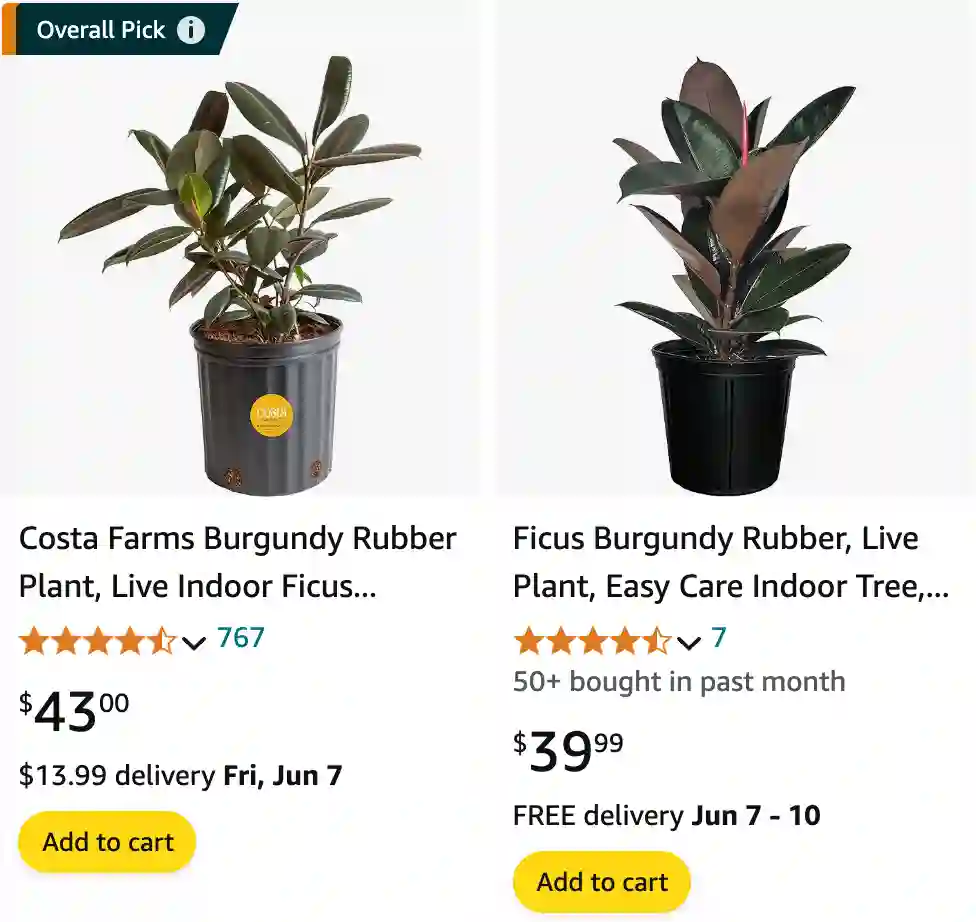
What is Ficus Elastica Burgundy?
Few houseplants hold the same stately presence as the Ficus Elastica Burgundy. This stunning cultivar, also known as the Burgundy Rubber Tree, boasts deep, glossy leaves that unfurl a dramatic burgundy red before maturing to a near-black green. Beyond its captivating looks, the Ficus Elastica Burgundy is surprisingly easy to care for, making it a perfect choice for plant enthusiasts of all experience levels. As a fellow plant parent, I’ve compiled this guide to help you cultivate a thriving Ficus Elastica Burgundy in your own home.
880 Species in Genus Ficus
Ficus Elastica Burgundy vs Robusta
I find that Ficus Elastica Burgundy has a deeper, richer color compared to Ficus Robusta, which tends to be more vibrant green. The Burgundy variety adds a sophisticated touch to any room with its darker foliage.
Ficus Elastica Burgundy vs Ruby
Between Ficus Elastica Burgundy and Ruby, I prefer the Burgundy for its striking burgundy leaves that hold their color well even in different light conditions. Ficus Elastica Ruby, while beautiful, can sometimes appear more muted in comparison.
Ficus Elastica Burgundy vs Black Prince
Ficus Elastica Black Prince has a unique charm with its nearly black leaves, which create a dramatic contrast against other plants. However, I lean towards Burgundy for its overall easier maintenance and the depth of its burgundy hues, which blend seamlessly into various interior styles.
Finding the Perfect Spot for Your Ficus Elastica Burgundy
Light is key to keeping your Burgundy Rubber Tree happy. These plants thrive in medium, indirect light. A spot near a south or east-facing window that receives several hours of dappled sunlight each day is ideal. While they can tolerate lower light conditions, insufficient light can lead to leggy growth with sparse foliage. Conversely, direct sunlight can scorch the leaves. Rotate your plant occasionally to ensure even growth.
Watering Wisely: Keeping Your Ficus Elastica Burgundy Hydrated
One of the biggest mistakes new plant parents make is overwatering. The Ficus Elastica Burgundy prefers to dry out slightly between waterings. A good rule of thumb is to stick your finger into the soil – if the top inch feels dry, it’s time to water. Soak the soil thoroughly until water runs out the drainage holes, then allow the excess to drain completely. Leaving your plant sitting in water can lead to root rot. During the cooler winter months, you may need to water even less frequently.
Humidity: Mimicking the Tropics for a Happy Plant
The Ficus Elastica Burgundy hails from the rainforests of Southeast Asia, where humidity levels are naturally high. While your home environment may not perfectly replicate those conditions, providing some extra humidity can benefit your plant. Grouping your Burgundy Rubber Tree with other humidity-loving plants can create a microclimate or using a pebble tray filled with water placed beneath the pot (ensuring the pot doesn’t sit directly in the water). Occasional misting can also help, but be mindful that excessive misting can promote fungal diseases.
Feeding Your Ficus Elastica Burgundy for Optimal Growth
During the spring and summer growing seasons, you can give your Burgundy Rubber Tree a monthly boost with a balanced, diluted liquid fertilizer. A general-purpose houseplant fertilizer should suffice. However, avoid over-fertilizing, which can lead to salt buildup in the soil and damage the roots. During the fall and winter, when growth slows, fertilizing is not necessary.
Maintaining Your Ficus Elastica Burgundy’s Majesty
Regular cleaning can keep your Ficus Elastica Burgundy looking its best. Dust can build up on the large, glossy leaves, dulling their shine. Simply wipe them down with a damp cloth to restore their luster. Additionally, you may need to prune your plant occasionally to maintain its size and shape. Use sharp, sterilized pruning shears to remove leggy stems or unwanted growth. Remember, the milky sap of the Ficus Elastica Burgundy can be irritating, so wear gloves when pruning.
Potential Challenges and Solutions: Keeping Your Burgundy Rubber Tree Thriving
While generally a low-maintenance plant, there are a few potential issues you may encounter with your Ficus Elastica Burgundy. Leaf drop can be caused by a variety of factors, including underwatering, overwatering, sudden changes in light or temperature, or pests. Identify the potential cause and adjust your care routine accordingly. Brown, crispy leaves are often a sign of underwatering, while yellowing leaves can indicate overwatering or insufficient light.
Pests like mealybugs and scale can occasionally target your Burgundy Rubber Tree. Treating them promptly with insecticidal soap or neem oil will usually do the trick.
The Reward: A Thriving Ficus Elastica Burgundy
With proper care, your Ficus Elastica Burgundy will reward you with years of vibrant foliage and stately presence. Not only does it add a touch of sophistication to your home décor, but it’s also known for its air-purifying properties, helping to remove toxins from the atmosphere. So, if you’re looking for a low-maintenance houseplant with a big impact, the Ficus Elastica Burgundy is an excellent choice. With a little TLC, you can cultivate a thriving specimen that will become a cherished addition to your indoor jungle.
If i die, water my plants!



